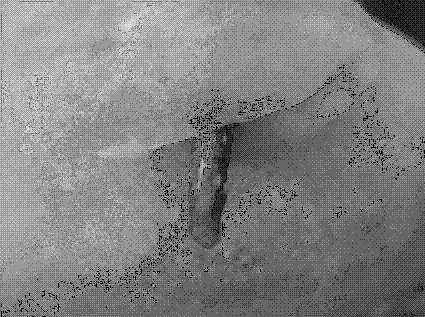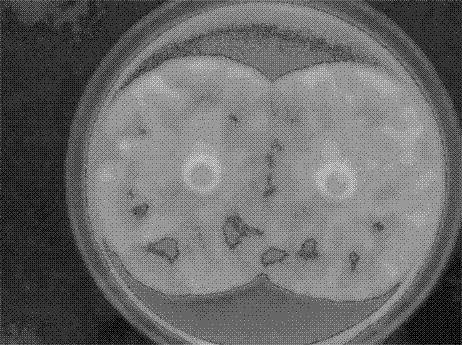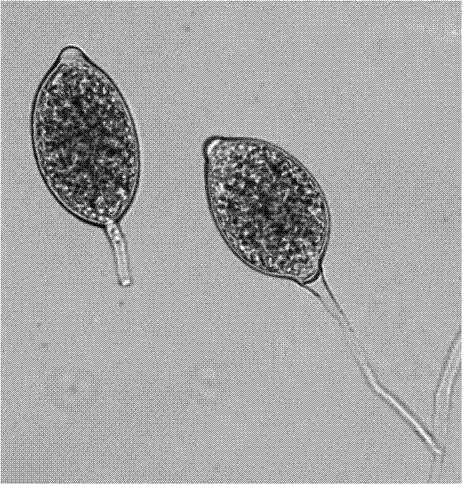Method for efficiently separating Phytophthora capsici from aging disease tissue
A technology for Phytophthora capsici and pepper blight, applied in the direction of microorganism-based methods, biochemical equipment and methods, fungi, etc., can solve the problems of low separation efficiency, difficult separation and purification, relatively high requirements for disease samples, and achieve high separation efficiency , simple operation steps, the effect of eliminating pollution
- Summary
- Abstract
- Description
- Claims
- Application Information
AI Technical Summary
Problems solved by technology
Method used
Image
Examples
Embodiment 1
[0025] The root samples collected from the vegetable base of Xindian Town, Fuzhou City, Fujian Province in the late stage of pepper blight were selected, and the isolation of Phytophthora capsici was carried out according to the following procedures:
[0026] (1) Take the aged root of pepper blight back to the laboratory, wash the soil and debris on the surface with tap water, scrape off the root skin with a utility knife, and cut it into tissue with a length of 2cm. If the diameter of the root exceeds 0.5cm, The xylem needs to be cut in half in the longitudinal direction on average. In a sterile ultra-clean bench, the cut tissue should be rinsed with sterile water for 3 times, soaked in 75% ethanol for 1.5 min, rinsed with sterile water for 3 times, and placed in an sterilized container. Blow dry the surface moisture in the ultra-clean bench;
[0027] (2) Rinse the prepared cucumber fruit under tap water to clean the surface debris, soak it in 75% ethanol for 0.5min, take it ...
Embodiment 2
[0033] The stem samples collected from the vegetable base of Xindian Town, Fuzhou City, Fujian Province in the late stage of pepper blight were selected, and the isolation of Phytophthora capsici was carried out according to the following procedures:
[0034] (1) Take the sample of the aged stem part of the pepper blight back to the laboratory, rinse off the surface debris with tap water, scrape off the skin with a utility knife, and cut it into stem tissue with a length of 2 cm. If the diameter of the stem part exceeds 0.5cm, it is necessary to split the xylem in half along the longitudinal direction. In a sterile ultra-clean bench, the stems are rinsed with sterile water for 3 times, soaked in 70% ethanol for 1.5min, rinsed with sterile water for 3 times, and placed in In the sterilized petri dish, dry the surface moisture in the ultra-clean workbench;
[0035] (2) Rinse the prepared cucumber fruit under tap water to clean the surface debris, soak in 70% ethanol for 1.0min, ...
Embodiment 3
[0041] The pepper fruits collected from the vegetable base of Nankou Town, Shaxian County, Fujian Province in the late stage of pepper blight were selected, and the isolation of Phytophthora capsici was carried out according to the following procedures:
[0042] (1) Take the aging diseased fruit samples of pepper blight back to the laboratory, rinse the surface debris with tap water, cut into pulp tissue with an area not larger than 2×2cm, and rinse the pulp tissue with sterile water in a sterile ultra-clean bench 3 times, soak in 80% ethanol for 1 min, rinse with sterile water 3 times, place in a sterilized petri dish, and dry the surface moisture in an ultra-clean workbench;
[0043] (2) Rinse the prepared cucumber fruit under tap water to clean the surface debris, soak it in 75% ethanol for 0.5min, take it out, and dry the remaining ethanol on the surface on the flame of a wine lamp, and use a sterile utility blade to clean it An opening of an appropriate size is cut at the...
PUM
| Property | Measurement | Unit |
|---|---|---|
| thickness | aaaaa | aaaaa |
Abstract
Description
Claims
Application Information
 Login to View More
Login to View More - R&D
- Intellectual Property
- Life Sciences
- Materials
- Tech Scout
- Unparalleled Data Quality
- Higher Quality Content
- 60% Fewer Hallucinations
Browse by: Latest US Patents, China's latest patents, Technical Efficacy Thesaurus, Application Domain, Technology Topic, Popular Technical Reports.
© 2025 PatSnap. All rights reserved.Legal|Privacy policy|Modern Slavery Act Transparency Statement|Sitemap|About US| Contact US: help@patsnap.com



